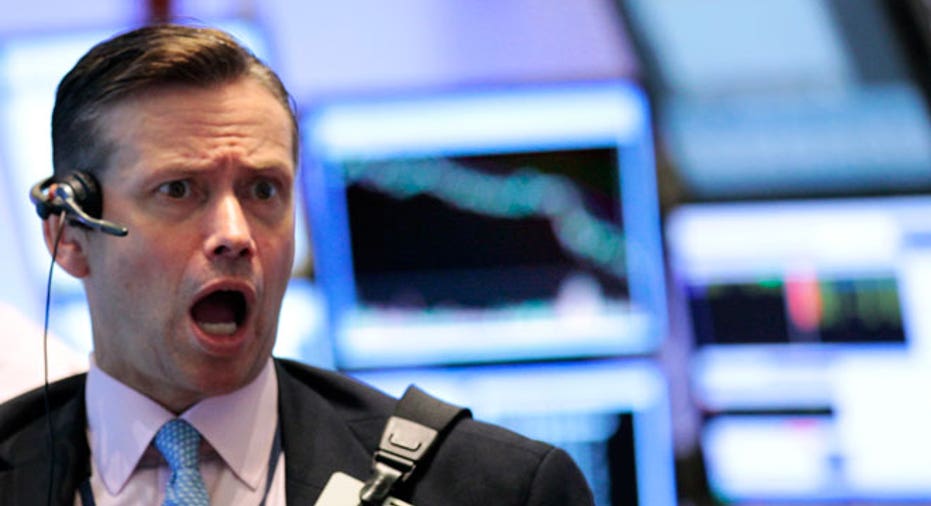Why the Slow Death of QE is Scaring Wall Street

The Federal Reserve signaled this week that the U.S. economy may soon be healthy enough to stand on its own after three years of being propped up by trillions of dollars of bond purchases.
While that is seemingly a positive development, it has triggered a wave of selling on Wall Street and in bond markets, with the Dow Industrials plunging as much as 460 points in just two days.
So what gives?
The Fed dialing back on quantitative easing is tantamount to removing the training wheels on the bike of a child who has grown far too accustomed to the extra support. It’s good news that the artificial assistance is no longer needed, but don’t expect the ride to be nearly as fast, at least at first.
By slowly removing the training wheels on the economy, high-yielding assets like equities are no longer considered risk-free by investors who bid stocks to all-time highs on the backing of easy-money policies from the Fed.
“The sooner the market can get on its own two feet, the better it will be for the quality of the recovery,” said Peter Kenny, chief market strategist at Knight Capital Group (NYSE:KCG). “But the risk-less bid is out of the market.”
QE Jitters Spark Rapid Retreat
All of this helps explain why stock prices have experienced higher volatility and increased selling since Fed chief Ben Bernanke’s May 22 testimony on Capitol Hill that signaled the central bank may soon scale back its monthly purchases of $85 billion of bonds.
During the ensuing 21 sessions, the blue chips have seen 10 200-point intraday swings, compared with four such wild moves during the nearly five months before Bernanke’s testimony.
“We’ve got a market that’s suffering the equivalent of alcoholism and there’s no AA,” said Ernie Patrikis, former general counsel of the New York Fed.
“Accommodative easing by nature has to stop being accommodating at some point otherwise it becomes destructive."
The selloff on the equity side is nothing new as each iteration of QE has triggered a steep pullback. After initially staying afloat, the S&P 500 tumbled about 16% after QE1 ended in March 2010. QE2 was then signaled in August 2010, but once it ended in June 2011 the S&P 500 lost another 18%.
Meanwhile, bond prices have followed stocks south of late, with the yield on the 10-year Treasury note climbing to 2.308% on Wednesday, the highest level since March 2012 and up from just 1.759% at the start of the year. Yields move in the opposite direction of bond prices.
Economic Optimism at the Fed
With interest rates already at zero, Bernanke’s controversial QE experiment to purchase bonds sought to lower long-term interest rates while simultaneously making riskier assets like stocks and real estate more attractive.
Once that program is unwound, ideally before sparking a bout of inflation, it stands to reason that those high-yielding assets will look less attractive comparatively.
“Accommodative easing by nature has to stop being accommodating at some point otherwise it becomes destructive,” said Kenny.
By disclosing on Wednesday that the Fed may ease off the gas pedal in terms of bond purchases later this year, Bernanke demonstrated increased confidence in the strength of the recovery.
The central bank now sees unemployment slipping to 7.2% - 7.3% by the end of the year and gross domestic product growth hitting zooming as high as 3.5% next year.
“The fact of the matter is that the economy has substantially improved in terms of its growth metrics: housing, employment, GDP expansion, energy production," said Kenny.
'Not Inevitable’
But it’s very important to note that Bernanke said the scaling back of bond purchases is contingent on the economy hitting specific growth metrics, ones that look optimistic compared with private estimates and given the Fed’s track record of overly-sunny forecasts (see: 2007).
While Wall Street projects GDP growth at 2.7% in 2014, the Fed now sees the economy growing at a far healthier 3% to 3.5% range.
“The Fed staff is bright, competent and well educated. Yet, the history of Fed projections is, at least by Wall Street folklore, spotty at best,” Art Cashin, director of NYSE floor operations at UBS (NYSE:UBS), wrote in a note to clients.
Bernanke also said automatically hitting the growth thresholds won’t automatically trigger tapering and even if the Fed does slow down asset purchases, it can reverse them.
“Tapering does not seem inevitable and imminent when looked at this way,” Michael Block, chief strategist at Rhino Trading Partners, wrote in a note.
Good News is Good, Right?
At the same time, some strategists note that higher bond yields, which signal more expensive borrowing costs, do not necessarily mean stock prices have to go south.
Dan Greenhaus, chief global strategist at BTIG, pointed out that bond yields experienced an even more rapid increase in 2010 when the 10-year yield surged from 2.38% in early October to 3.53% in mid-December. Bond yields soared .78 percentage points during the fourth quarter and yet the S&P 500 still managed to jump 10%.
“This is another example of our ongoing argument that increases in interest rates, by themselves, do not have to warrant lower equity prices,” Greenhaus wrote in a note.
All of the increased focus on when the Fed will dial back on QE has renewed a peculiar phenomenon on Wall Street: positive economic news triggers selling because it moves up the date for when the easy-money punch bowl will be removed.
Already down 165 points, the Dow tumbled another 88 points on Thursday after the Philly Fed said a key mid-Atlantic manufacturing index unexpectedly surged in June to its best level since April 2011.
Traders read that bullish economic report as another nail in the QE coffin.
“One thing is for sure. Bad is good again. Good is bad. Great,” Block said.



















